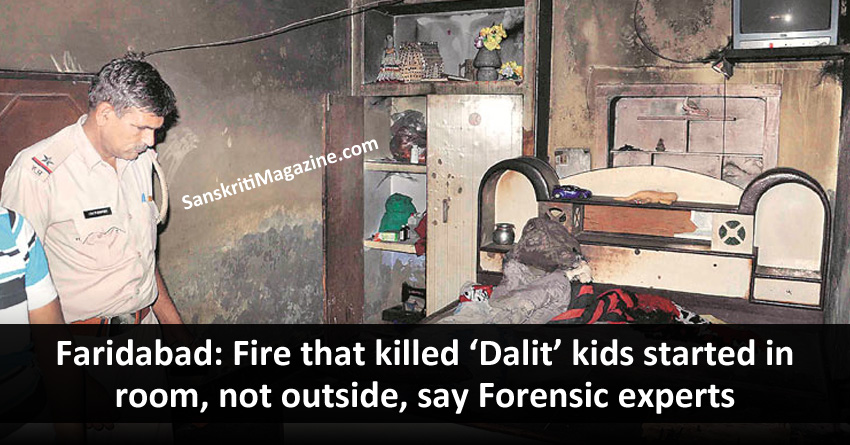The FSL report has mentioned that the door was bolted from inside. The team studied the pattern of smoke-ash traces on the bolt to reach this conclusion that the door was bolted from inside.
As the CBI registered a case over the October 20 incident in a Faridabad village where two children were burnt alive in an alleged attack by upper caste Rajputs, Haryana forensic experts, who inspected the scene of crime in Sunpedh, concluded that the “origin and source of fire was from inside the room and not from outside”.
Forensic experts have also found a half-burnt kerosene oil plastic bottle under the partially burnt bed and a burnt matchstick lying on a slab next to the window of the room.
The team, comprising Director, Forensic Science Laboratory (FSL) and Assistant Directors of the Physics and Chemistry divisions of the FSL, Karnal, is of the unanimous opinion that the fire originated from “within the room”. It is likely to submit its report to the CBI by this weekend.
The forensic findings trashes the version of complainant Jitender — his two children were burnt alive and his wife Rekha is at the Safdarjung Hospital in Delhi with over 30 per cent burns — who alleged that he and his family were attacked by Rajputs as they slept in their house. Seven of the eleven accused in the case have been arrested.
Highly placed sources in the FSL said the forensic examination report on the spot also mentioned “no traces of outside entry” into the premises when the alleged attack took place.
The experts also concluded that the pattern of pouring of inflammable substance was “vertical” — this is not possible if the woman, Rekha, was lying on the bed. Sources in the FSL said that the “splatter’s pattern on the scene of crime was circular, which indicates that it was not thrown from a distance, but poured from the place where it was later put on fire.
The house has two rooms. Jitender, in his statement to police, had alleged that he took out his children from a hole that connects one room with another. However, forensic experts have rejected this claim, saying the diameter of the hole is not adequate for a person to cross through.
The FSL report has mentioned that the door was bolted from inside. The team studied the pattern of smoke-ash traces on the bolt to reach this conclusion that the door was bolted from inside.
The experts found that the window from which Jitender alleged that inflammable substance (petrol, according to him) was thrown inside the room was “shut, although not bolted”.
Jitender alleged that 11 people gained entry to his premises by scaling the walls and then attacked him and his family. But the forensic experts, sources said, pointed out that there were plants next to the wall. “If anybody would scale the wall, there would be some disturbance in that area. There was no such disturbance witnessed in that area,” sources said.
A Haryana police officer said Rekha, who sustained over 30 per cent burn injuries, was declared fit by doctors to make a statement on the very day of the incident. But she refused to give a statement, a fact that was recorded by Faridabad police in its case diary. The next day, a Delhi magistrate was asked to record her statement at Safdarjung Hospital but he declined, citing jurisdiction issues.
The next day, Rekha’s statement was finally recorded by a sub-divisional magistrate (SDM) in which she corroborated Jitender’s allegations — as was reported by The Indian Express — but did not give much details about the incident. She did not name anybody and told the SDM that her husband knew the names of people who attacked them, the police officer said.











